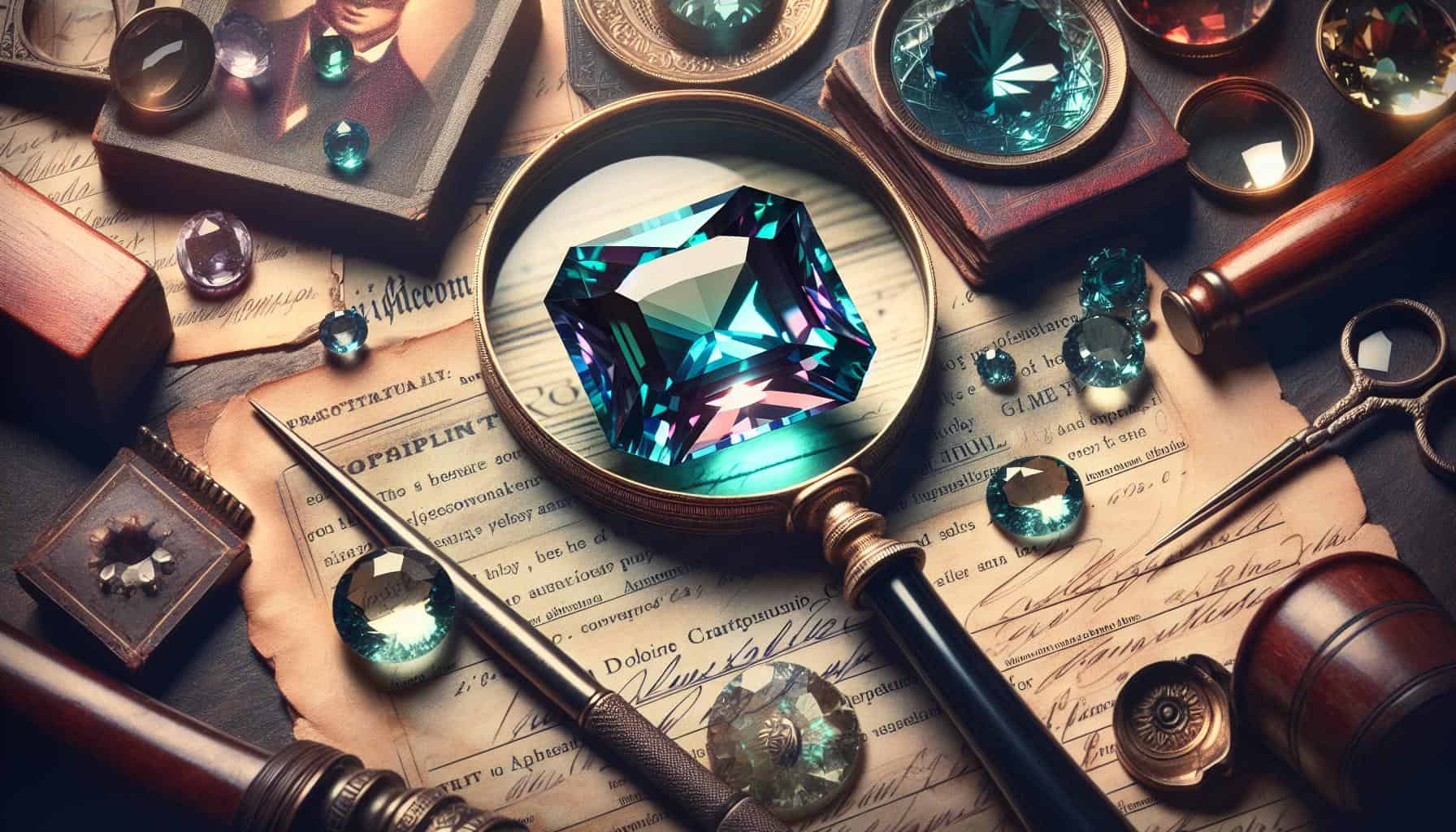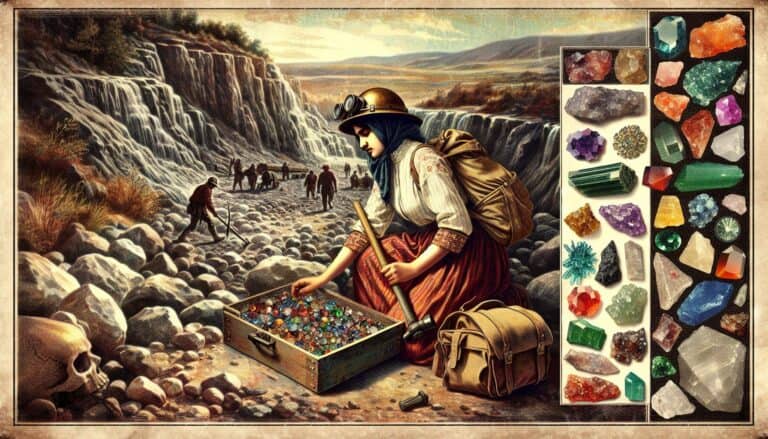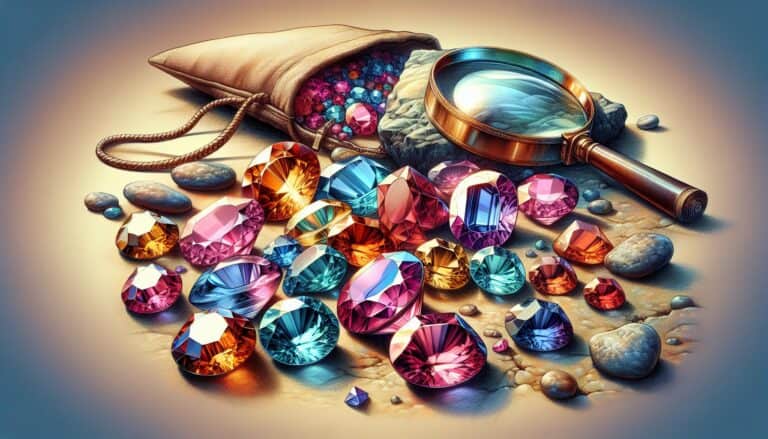Ever wondered what makes alexandrite one of the most coveted gems in the world?
It’s not just its stunning color-change ability that captures the eye, but also the hefty price tag it commands. As a chameleon of the gemstone world, alexandrite’s value can be quite the enigma.
You’re about to dive into the factors that determine how much alexandrite is worth. Rarity, quality, and size play pivotal roles in its valuation. Whether you’re a collector, an investor, or simply curious, understanding alexandrite’s worth is as fascinating as the gem itself.
Let’s unravel the mystery behind its value.
Alexandrite’s value hinges on color change strength, clarity, cut, and carat weight. The more pronounced the color change, the higher the value. Stones with minimal visible inclusions are prized, and expertly cut alexandrites showing even color change are more valuable. Larger, high-quality stones are significantly rarer, increasing value.
What Is Alexandrite?
Alexandrite is a rare, color-changing variety of the mineral chrysoberyl. Discovered in the Ural Mountains of Russia in the 1830s, it was named after the then-future Tsar Alexander II. The gemstone’s hallmark is its striking ability to change color under different lighting conditions. In daylight or fluorescent light, the stone exhibits shades of green to bluish-green. Under incandescent lighting, it transforms to purplish-red to red colors. This unique optical phenomenon is known as the alexandrite effect.
Due to its rarity, alexandrite is often described as an “emerald by day, ruby by night.” Throughout history, it has been coveted by jewelry collectors and gem enthusiasts alike. But it’s not just its fascinating color shift that makes alexandrite so valuable.
Alexandrite scores 8.5 on the Mohs scale of hardness, marking it as a durable gem suitable for everyday wear. Furthermore, its rarity is underscored by the limited geographic presence of high-quality deposits. Significant sources of the gemstone are found in Brazil, Sri Lanka, and parts of Africa, though the Russian origin stones are considered the most premium due to their more intense color change and historical significance.
Among the factors that determine alexandrite’s worth are:
- Color Strength: The more pronounced the color change, the more valuable the gemstone.
- Clarity: Stones with fewer inclusions are rarer and fetch higher prices.
- Cut: A well-cut alexandrite will show the color change evenly and maximize the gem’s brilliance.
- Carat Weight: Larger stones are significantly rarer, especially if they maintain high clarity and color quality.
As a gemstone that embodies both beauty and durability, alexandrite remains a top choice for collectors seeking something extraordinary. Whether it’s used in a ring, pendant, or another piece of jewelry, the unique characteristics of alexandrite make it stand out in the world of precious stones. With its mesmerizing play of colors, it’s easy to understand why those who encounter alexandrite are often captivated by its allure.
Alexandrite Prices: Factors That Affect Value

When looking to understand how much alexandrite is worth, it’s crucial to consider several key factors that significantly impact its value. Your knowledge of these factors will help you make informed decisions whether you’re buying or selling this remarkable gemstone.
Color, Clarity, and Cut Quality
Color is arguably the most defining characteristic of alexandrite. The most prized stones exhibit a vivid green to bluish-green color in daylight or fluorescent light and an intense red to purplish-red in incandescent light. The degree of color change is often described as weak, moderate, or strong, and stronger color changes generally lead to higher prices.
Clarity refers to the presence of inclusions in a gemstone. Alexandrites are Type II gems, which means they typically contain inclusions. However, stones with fewer visible inclusions fetch higher prices. Remember, minor inclusions don’t usually affect the stone’s durability but they can impact its desirability and value.
Cut quality influences how well a gemstone reflects light, thus enhancing its color change and overall appearance. A well-executed cut is essential for maximizing the stone’s beauty. Gems with high-quality cuts that display the color change phenomenon to its full extent are considered more valuable.
Here are some factors that influence Alexandrite’s worth:
- Color intensity and saturation
- Clarity of the gemstone
- Precision of the cut
- Symmetry and finish of the gemstone
Market Demand and Availability
Market demand significantly affects alexandrite pricing. Due to its rarity and the increasing desire from collectors and enthusiasts, demand for alexandrite has remained consistently high. This trend results in prices that often surpass other equally beautiful gemstones.
Availability plays a critical role as well. Alexandrite sources are limited, with past deposits in Russia largely depleted and current mining operations in Brazil, Sri Lanka, and East Africa producing small quantities. As mines yield fewer high-quality specimens, the rarity of these stones contributes to their steep prices.
Factors influencing market dynamics include:
- Rarity and uniqueness of the gemstone
- Current trends in the jewelry industry
- The economic situation affecting luxury goods
In addition to current market conditions, historical significance and cultural associations bolster alexandrite’s esteem, influencing its market value. While assessing alexandrite’s value, consider these nuances of market demand and availability to truly gauge why this gemstone’s pricings can vary so drastically.
Understanding Alexandrite: A Rare Gem

The Rarity of Alexandrite
When you’re exploring the world of precious stones, you’ll find that alexandrite stands out due to its exceptional rarity. Discovered in the Ural Mountains of Russia in the 1830s, this gemstone has captivated enthusiasts ever since. The scarcity of alexandrite arises from its very specific formation conditions. It forms only when two mineral compounds, which rarely exist together, interact in just the right way. These unique circumstances mean that finding alexandrite is extremely uncommon.
The severe scarcity of natural alexandrite has led to a surge in lab-created stones. These synthetics can echo the color change alexandrite is known for but lack the history and rarity that make natural stones so valuable. Your understanding of genuine alexandrite’s worth must account for its limited natural quantities.
Origins and Characteristics
Alexandrite claims an intriguing origin story that adds to its allure. It was named after the Russian Tsar Alexander II and is steeped in a rich history that endears it to collectors and history buffs alike. While the original Russian mines have long been exhausted, new sources have been discovered in Brazil, Sri Lanka, and East Africa, expanding the availability of this rare gem—yet not nearly enough to meet the ever-growing demand.
The unique characteristics of alexandrite are what drive aficionados to seek out this gem. Notably, its remarkable color-changing ability—which ranges from green in daylight to red in incandescent light—is caused by trace amounts of chromium in its structure. Alongside this, the stone’s physical properties, such as hardness, also make it a durable option for jewelry.
Breaking down alexandrite’s traits, you’re looking at:
- A hardness of 8.5 on the Mohs scale
- A refractive index of 1.746-1.755
- Specific gravity of approximately 3.5
The optimal combination of these characteristics ensures that alexandrite is not only beautiful but also resilient enough for everyday wear. Whether set in a ring, pendant, or earrings, its ability to exhibit two colors depending on the lighting conditions ensures that it never fails to attract attention and admiration.
Alexandrite Grading and Valuation
The Grading System for Alexandrite
Understanding the grading system for alexandrite is crucial when determining its value. Much like diamonds, alexandrite gemstones are evaluated based on several key quality factors including color, clarity, cut, and carat weight—an approach known among industry professionals as the “Four Cs.”
- Color: This is the most significant factor when grading alexandrite. You’ll find that the ideal stone displays a striking green to bluish-green hue in daylight and a deep red to purplish-red under incandescent lighting. The more vivid and distinct the color change, the higher the gemstone’s value.
- Clarity: Alexandrite with fewer inclusions or blemishes is more valuable. High clarity allows for an unobstructed view of the stone’s color change effect.
- Cut: The cut of alexandrite doesn’t just refer to its shape, but also how well it showcases the gem’s optical properties. A well-executed cut enhances the stone’s color change and overall brilliance.
- Carat Weight: Larger stones of exceptional quality are rare and command higher prices. However, as carat weight increases, so does the visibility of any inclusions, potentially impacting the stone’s clarity.
Certification and Appraisal
When investing in alexandrite, obtaining a certification from a reputable gemological laboratory is essential. The certification authenticates the gemstone’s natural origin and color change phenomenon, confirming its quality and ensuring that you’re getting the value you’re paying for.
During the appraisal, expert gemologists assess the stone using standardized grading scales for each of the Four Cs, keeping in mind the geographical origin as well. Alexandrite from specific locations like Russia may be more highly valued due to its historical importance in the gem world.
Here are some key points you should look for in an alexandrite certificate:
- Origin: Certifies the geographical location where the stone was mined.
- Photograph: A high-resolution image documents the appearance under different lighting conditions.
- Grading Analysis: A detailed report on the stone’s color, clarity, cut, and carat weight.
An appraisal differs from certification as it assigns a monetary value to the gemstone, often required for insurance purposes. Always choose an independent and certified gemologist or appraiser with extensive experience in colored gemstones to get an accurate assessment of your alexandrite’s worth.
Current Market Trends in Alexandrite Pricing
When delving into the pricing trends of alexandrite, you’ll quickly find that high-quality stones are commanding top dollar in today’s market. The rarity and uniqueness of this gemstone have kept its demand consistently high, while the available supply remains relatively low. Investors and collectors alike are willing to pay a premium for specimens that showcase the dramatic color change alexandrite is famous for.
Prices for alexandrite can vary wildly based on size, quality, and origin. Russian alexandrite, revered for its rich history and exceptional quality, often fetches higher prices. Recent trends indicate a noticeable preference for particular shades, with pure hues in both green and red, without any brownish tint, being the most sought after. Alexandrite from Brazil and other new sources typically offers a more affordable price point but may lack the exceptional color change seen in the Russian stones.
As you’re considering an investment in alexandrite, it’s important to understand the impact of carat weight on its price. Here’s a snapshot of how weight can influence cost:
| Carat Weight | Price Range (USD) |
|---|---|
| Under 1 Carat | $1,500 – $15,000 |
| 1 to 2 Carats | $15,000 – $50,000 |
| Over 2 Carats | $50,000 and above (prices can exceed $70,000 for stones with exceptional quality) |
Please note that these figures are ballpark estimates and can vary based on the factors previously discussed such as color, clarity, and origin. It’s also essential to recognize that alexandrite over 3 carats is exceedingly rare and significantly more valuable, with these larger sizes often being sold through high-end auction houses.
With technology advancements, lab-created alexandrite has emerged as a more accessible option. While these synthetic stones feature similar optical properties, they are considerably less valuable. If you’re in the market for natural alexandrite, always ensure it comes with proper certification to verify its authenticity.
In the dynamic gemstone market, staying informed about these trends is vital as they influence the valuation and appraisal of alexandrite, whether you’re looking to sell or expand your collection. Keep an eye on auction results and market reports from reputable sources, as they’ll give you a clearer picture of the going rates for this highly prized gemstone.
The Most Expensive Alexandrite
Have you ever wondered just how steep the price tag can go for top-tier alexandrite? Record-breaking sales at auctions reveal the staggering sums collectors are willing to pay for this rare gem. Exceptional alexandrite specimens can command prices well over $100,000 per carat. This price is a reflection of the perfect storm of rarity, beauty, and mystique that alexandrite embodies.
One of the factors that drive up the value is the origin of the stone. Historically, Russian alexandrites fetch the highest prices due to their historical significance and the purity of their color change. The renowned jewels from the Ural Mountains set the standard for this beguiling gemstone. In contrast, stones sourced from newer deposits like Brazil, Sri Lanka, and East Africa may not compare in terms of historical value but can still command high prices based on quality.
The most expensive alexandrite exhibits a distinct and dramatic shift from green to red, mirroring the national colors of Imperial Russia. It’s this color change that captivates and is most sought after by gem enthusiasts. Size also plays a critical role; larger stones are rarer and, therefore, exponentially more valuable. For comparison, here’s a snapshot of how carat weight affects value:
| Carat Weight | Approximate Value |
|---|---|
| 1 to 3 | $50,000 – $150,000 |
| 3 to 5 | $150,000 – $300,000 |
| Over 5 | $300,000+ |
Bear in mind these figures can vary widely depending on the individual stone’s quality. Besides carat weight, aspects such as clarity and precision of the cut can make all the difference. An impeccably clear and expertly cut alexandrite will top the charts in terms of desirability and cost.
Interestingly, the allure of alexandrite extends beyond its physical attributes. Stories and folklore surrounding the gem add intangible value; for some collectors, the historical and cultural significance weigh just as heavily as carat weight and color change.
Buying Alexandrite: Tips and Recommendations
When you’re in the market for alexandrite, knowing where and how to purchase high-quality specimens is crucial to ensure you’re making a worthwhile investment. Your approach should be methodical and informed, considering the rarity and significant value attached to this unique gemstone.
Where to Purchase High-Quality Alexandrite
Alexandrite can be found in a variety of settings, from high-end jewelry stores to specialized gemstone dealers. It’s essential to prioritize reputable sources that specialize in colored gemstones. Consider the following venues:
- Certified Gemstone Dealers: Look for dealers who are members of recognized industry organizations, such as the American Gem Trade Association (AGTA).
- Jewelry Stores with a High Reputation: Choose stores known for their quality and service, ideally those which offer a selection of fine colored gemstones.
- Auctions: Auction houses like Sotheby’s or Christie’s occasionally feature fine alexandrite pieces. Be prepared to do your due diligence before participating.
- Gem Shows: Attending a gem and mineral show allows you to view a wide selection of alexandrite and speak directly with experts.
Online markets have become prominent, but caution is advised. Always ensure the dealer has a strong return policy and ample positive reviews before committing to an online purchase.
Ensuring Authenticity and Value
With the high value of alexandrite, it’s vital to take steps to verify the authenticity and worth of the stone:
- Certification: Always ask for a gemstone certificate from reputable gemological laboratories such as GIA or AGL which will confirm the stone’s natural origin and color change.
- Appraisals: Obtain an independent appraisal from a certified gemologist to establish the stone’s market value. This is particularly important for insurance and resale purposes.
- Visual Inspection: Familiarize yourself with the quality factors of alexandrite and closely inspect the gem for its color change, clarity, and cut quality.
Understanding the hallmarks of quality in alexandrite and taking a careful approach to verify the stone’s credentials will not only ensure you’re getting what you pay for but also safeguard your investment in the long run.
When buying alexandrite, patience and research pay off, allowing you to add a piece to your collection that meets your aesthetic preferences and investment criteria. Remember, the intrinsic beauty and rarity of alexandrite make it a treasure worthy of the discerning collector.
Conclusion: Buying & Selling Alexandrite
Discovering the true worth of alexandrite requires more than a glance at its price tag.
It’s about understanding the nuances of this gemstone’s quality and securing your investment with diligence. Remember, the journey to owning a piece of this chameleon-like stone is as unique as the gem itself. Trust in the process of verification, arm yourself with knowledge, and you’ll find that the value of alexandrite is not just in its rarity but in the satisfaction of making an informed, confident choice.
Cherish your alexandrite, knowing you’ve navigated the complexities of its acquisition with expertise.







